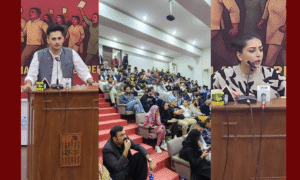This essay by Huda Raza gives a careful examination of the interplay between corrupt practices and environmental degradation .
Corruption is the misuse of public power for private gains while the physical surroundings of earth, in which a person, animal, or plant lives and operates, is called the environment. Corruption is a centuries-old, cross-cultural reality that is found in every society, political culture, and system. Thus, one of the influencing factors that affect the sustainability of the natural environment is corruption, which lowers the standard and effectiveness of green projects and regulations. The more corruption there is in a society, the less strictly environmental policies and rules are enforced. Also, corruption goes hand-in-hand with public debt. It is a hurdle in the world’s aim towards transitioning to a low-carbon economy. So, I believe that environment and corruption are inversely related.
Lack of transparency in the decision-making of dams’ location, misallocation of funds, and poor construction processes spoil water systems. Therefore, corruption is not only related to politics and money but also includes abuse, emission, and misappropriation.
Corrupt practices in the environmental sector can have serious consequences. This includes embezzlement in the implementation phase of environmental programs, grand corruption when permits and licenses for natural resources exploitation are issued, as well as petty bribery by law enforcement officers. It can also occur in the early stages of the resource exploitation process, as well as in the course of an operation. These offenses may be committed at any level, whether it is local, national, or international. It can cause the destruction of ecosystems, habitats, and resources. This could have direct or indirect implications for the livelihood of local residents.
The more corruption there is in a society, the less strictly environmental policies and rules are enforced. Also, corruption goes hand-in-hand with public debt. It is a hurdle in the world’s aim towards transitioning to a low-carbon economy.
Therefore, in the renewable resources sector, it entails corruption occurring in the forest sector, influencing forest management and conservation. For instance, more timber is extracted than authorized. These timber companies bribe the officials and bureaucrats to ignore inconvenient environmental regulations and under-report the amount of harvesting. Deforestation leads to landslides, forest fires, and poaching of forest species. Moreover, in the non-renewable resources sector, mining operations produce smelting gases, chemicals, and air pollutants. Lax environmental laws and corrupt officials allow companies operating in this industry to regulate themselves in exchange for kickbacks. Illegal mining activities cause massive soil erosion and land degradation. Furthermore, in the infrastructure sector, the environmental harm caused by large dams, which disturb hydrological flows and damage the marine ecosystem, can be made worse by corruption. Lack of transparency in the decision-making of dams’ location, misallocation of funds, and poor construction processes spoil water systems. Therefore, corruption is not only related to politics and money but also includes abuse, emission, and misappropriation.
Moreover, corruption is also a problem in many sectors, which include illegal trade in endangered species and forestry, hazardous waste management, exploitation, fisheries, and water supply. Sometimes, Multilateral Environment Agreements may be complied with by countries that have passed environmental laws. However, corruption hinders the enforcement of such laws. Some activities or practices that are not sustainable can be permitted to continue if there are no regulations in certain areas, such as environmental protection or anti-corruption.
In order to combat corruption in the environmental zone, it is essential to improve transparency, accountability, democracy, and good governance. For the legal framework to be strengthened, it is vital that politicians and policymakers from resource-rich nations support this effort. But it is important not to diminish the importance of the foreign public and corporate or private partners that must agree to refrain from illegally exploiting natural resources. Local communities and the public can also contribute to transparency by asking questions about how these products are obtained and what the environmental consequences will be. The United Nations Convention against Corruption (UNCAC) provides a powerful tool for all stakeholders because it encourages comprehensive anti-corruption measures in the private as well as public sectors.
Hence, it can be said that environment and corruption are inseparable concepts and both of them are interdependent. Putting environmental management and integrity systems in place is not easy, but doing so is the need of the hour. Moral upbringing, societal values, and standards should all be taken into account in the battle against corruption since they are crucial. Only then, can we be able to efficiently prevent environmental degradation.
The writer is a student of International Relations at NDU.




